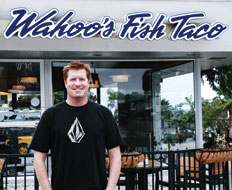If all introductions into the quick-serve market were as relaxed as Tal O’Farrell’s, everyone would be tempted to sign up.
O’Farrell is one of San Diego’s skateboard celebs as pioneer of the long-board and co-owner of Sector 9 skateboards. Looking to differentiate his portfolio with something that would appeal to the interests of other skateboarders, O’Farrell had a “board” meeting while surfing with Wahoo’s Fish Taco franchise staff. That meeting led to the opening of his first Wahoo’s in 2000; he now has two locations under his management, along with his continuing skate and surfboard businesses.
O’Farrell proves that the transition into the quick-serve world can include integration of businesses from an entirely different market.
1. No Matter the Business, the Customer Is First
Of course, selling someone a plate of food is a lot different than a skateboard, but the customer-service aspect is the same, or at least you should have the same philosophy. The goal should be to sell someone a product that provides more satisfaction than they can handle; this leads them to tell their friends and family, leading you to continuing growth.
I have the same mentality when I sell fish tacos as I do for a brand-new skateboard. With the skate and surf market, I might deal with warehouses and shops more so than the actual customer, but I make it a point to deal with the customers directly at shops.
If you are going from one market into the quick-serve world, your past customer service will really be put to the test, and if you’re not on point, it’ll be a rude awakening.
2. Keep All Businesses Assimilated
The biggest part when entering the quick-serve market is being the face of your brand and consistently being out there. The two business types don’t have to relate perfectly if you get out there and promote both at the same time.
If Wahoo’s signs up to cater a boarding event, I make sure that my boards are promoted in some way. Likewise, if some surf or skate event is using my boards, I’ll see if Wahoo’s can serve some food for the occasion.
I consistently keep the two together and they are never separate. If you don’t do that, your experience in one or the other is lessening by the minute and potentially losing customers in both. If it’s done right, the two different business plans can compliment one another.
3. Use Experience in One Business to Boost Another
The process itself was a fairly easy process and that has to do with whom you partner with. Coming from my position before owning a couple of Wahoo’s units, I was doing a lot of purchasing and sales with Sector 9. However, whatever the materials might be, you can forecast what you need or don’t need. Knowing how and what to purchase and being able to craft a deal should be in your arsenal beforehand.
The other part in the initial phases of combining two different business types is keeping an ear to the ground. What’s hot? What’s up and coming that has potential?
My colleague Steve Lake and I were craving Wahoo’s after surfing, knowing full and well there wasn’t one around. The next day, we sought out Wahoo’s associates and realized they matched our interests and, at the time, current business philosophies. We looked at the timeless quick serves out there and, not to take anything away from those brands, they were just not what we thought would take off. It was and can be as simple as just going with your interests.
Moreover, do something you would want to do as an everyday consumer. You need to have your finger on a pulse of what’s going on and be interested at how the combo can work together.
4. Stay Active in Good Times, Bad
You won’t know everything about the industry, first off, and most likely will have difficulties in the early stages. So what can you do? Get out there and be the face of a brand. When we started Wahoo’s in 2000, I already had great success as a skateboard shop owner and manager, but didn’t have a lot of quick-serve experience. So I stood behind the lines serving the catered events. I got out and talked to our customers first-hand and physically let them know what we had to offer.
The two business types will eventually catch up with one another, but first you need to create those connections and ensure a customer base. Be aware and crafty. It’s more organic for the customer when you’re out there, so don’t hide in the back hoping that the connection will happen by itself.
5. Never Get Complacent
Success in one business market doesn’t mean instant karma for the other. It’s really easy to take that success from another locale and get set in your ways, inevitably becoming complacent. Stay on your game and move forward.
Obviously, the market is different than it was 10 years ago, and our food costs have gone through the roof. Because it’s a smaller brand compared to the giants, we’ve had to stay on top of our margins more so than normal. But because we stayed on point, we made it through difficult times using our past experience as a guide.
Our skateboard company was on such a larger scale when it came to purchasing, and this made the quick-serve numbers a little easier to manage.
Finally, continue to use your experience with the other market to your advantage and never let the other slip out of your fingers. Your first business venture is just as important as your quick-serve one and will only benefit if you stay in it. In terms of time, anything that takes you away will hurt you in the long run.













